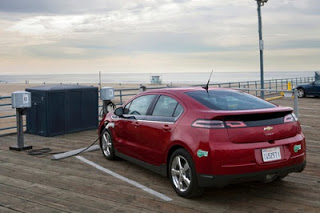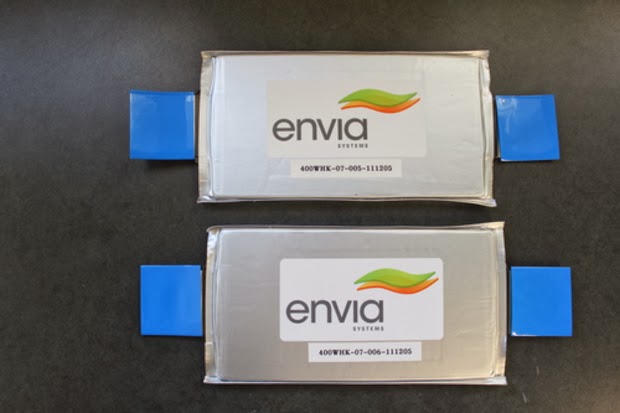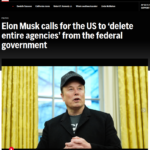The news is buzzing today with word that GM is working on a 200 mile range Chevy Volt. Bloomberg News has a report claiming that GM’s CEO Dan Akerson said this: “There will be breakthroughs in battery technology, they’re on the horizon. We’re actually developing a car today which is really anathema to the way the auto industry works: We’re running a dual play on the technology to see which one will succeed. One will result in a 100-mile range, the other will be a 200-mile range.”
This quote makes for great copy, and reinforces statements made by Akerson and other top GM management have said over the last year, but the official transcript of his speech at the CERAWeek conference has him saying no such thing. He had a lot of interesting things to say.. but .. oh well, maybe the quote came from a Q&A session or something. Let’s just pretend he actually said what Bloomberg reports him saying rather than quibble over whether he said it, or not. Because, actually, he and others in GM’s management have said similar things so this isn’t exactly a surprise for him to say it again.
 How can GM build a 200 mile range electric car? Simple, put in a large enough battery pack. It would require a 60 kilowatt-hour pack to credibly claim this kind of range. That’s what the Tesla Model S carries, and it’s driving range is about 200 miles. That’s 2.5x the energy carried by typical electric cars like the Nissan Leaf and of course a battery pack that size costs a pretty penny today. You could make room for the pack partly by ditching that stinky gas engine in the first place, and second designing the car correctly to provide space for the pack. Sorry GM but that T-shaped battery tunnel design has gotta go.
How can GM build a 200 mile range electric car? Simple, put in a large enough battery pack. It would require a 60 kilowatt-hour pack to credibly claim this kind of range. That’s what the Tesla Model S carries, and it’s driving range is about 200 miles. That’s 2.5x the energy carried by typical electric cars like the Nissan Leaf and of course a battery pack that size costs a pretty penny today. You could make room for the pack partly by ditching that stinky gas engine in the first place, and second designing the car correctly to provide space for the pack. Sorry GM but that T-shaped battery tunnel design has gotta go.
Would it still be called the Chevy Volt? Probably not.
The issue would be what price GM would have to charge. The 60 kwh Model S runs about $70 grand (I should check, but am too lazy to verify the price) which conventional wisdom says is unlikely to result in the sales volume befitting a GM car with a Chevrolet name plate. Somehow the price of this has to drop by quite a bit so that GM could put a semi-affordable price on it.
Fortunately GM has a research project going on that would result in just such a price breakthrough. And I’m confident that it’s not just GM but all the other automakers racing to find such a breakthrough.
I want to go over the steps along the way the things which GM has publicly revealed – because it seems likely they are close to a battery breakthrough which will result in lithium-ion batteries with twice the energy density at 1/4th the cost. That combination would drastically change the economics of battery packs and electric vehicles. Combine this sort of breakthrough with fast charging and you’ve got a very interesting new breed of electric cars on your hands.
Envia Systems battery breakthrough for affordable 300 mile range electric cars: A year ago Envia Systems, a lithium-ion battery design start-up in Newark CA, announced a battery energy density breakthrough that would have twice the energy density of regular lithium-ion, at 1/4 the cost. Their press information was full of 300 mile electric car stuff. The most interesting part of this is that GM Ventures is backing the company, that the company has a partnership with LG Chem, and that Envia, GM and LG Chem are all licensees of the same cathode technology developed by the Argonne National Laboratory.
“Twice the energy density” means 400 watt-hours/kilogram, when normal lithium-ion come in at 100-200 watt-hours/kilogram.
GM’s Akerson talks about auto industry bailout and a 140+ mile range Volt: About 3 weeks later Akerson started blabb..er..talking in public about designing a Chevy Volt with a much longer electric driving range. This particular statement came at a Commonwealth Club of San Francisco meeting during which Akerson met with a bunch of Volt owners. In case it’s not clear, he described a 140 mile electric driving range.
Electric cars to become inevitable, cost competitive, by 2020ish says report![]() : This is a report from McKinsey Quarterly which described a few trends that will make electric cars inevitable. One was falling battery pack costs, and increasing energy density. That’s essentially what we’re describing here.
: This is a report from McKinsey Quarterly which described a few trends that will make electric cars inevitable. One was falling battery pack costs, and increasing energy density. That’s essentially what we’re describing here.
GM’s Akerson promises 200 mile range electric car in a few years: By August Akerson was talking about a 200 mile range electric car, saying “I think we’ve got better than a 50-50 chance to develop a car that will
go to 200 miles on a charge. That would be a game changer.”
The Osborne Legacy, GM’s 200 mile electric car, and electric car adoption![]() and The Osborne Effect delaying real electric car purchasing: Shortly after Akerson’s 200 mile electric car claim just mentioned, I concocted this theory that such a claim might spook electric car buyers. If they think a much better car is just around the corner, would they delay buying until those better cars came out? If so would that scuttle the whole project of electric car adoption by drying up electric car purchases? The pattern is the Osborne Effect, named after an ill-fated personal computer company from the mid-80’s that died after the CEO announced a much better product was “just around the corner.”
and The Osborne Effect delaying real electric car purchasing: Shortly after Akerson’s 200 mile electric car claim just mentioned, I concocted this theory that such a claim might spook electric car buyers. If they think a much better car is just around the corner, would they delay buying until those better cars came out? If so would that scuttle the whole project of electric car adoption by drying up electric car purchases? The pattern is the Osborne Effect, named after an ill-fated personal computer company from the mid-80’s that died after the CEO announced a much better product was “just around the corner.”
Electric car range could triple with silicon-graphene breakthrough in lithium batteries![]() : This battery breakthrough is unrelated to GM, but I’m throwing it in as an example of other battery energy density research going on. Independent test results using full-cell lithium-ion battery cells designed by CalBattery demonstrate an energy density of 525 watt-hours per kilogram, and a specific anode capacity of 1,250 mili-amp-hours per gram. Most commercial batteries have an energy density in the 100-180 watt-hours per kilogram range, and specific anode capacity in the 325 mili-amp-hours per gram range.
: This battery breakthrough is unrelated to GM, but I’m throwing it in as an example of other battery energy density research going on. Independent test results using full-cell lithium-ion battery cells designed by CalBattery demonstrate an energy density of 525 watt-hours per kilogram, and a specific anode capacity of 1,250 mili-amp-hours per gram. Most commercial batteries have an energy density in the 100-180 watt-hours per kilogram range, and specific anode capacity in the 325 mili-amp-hours per gram range.
GM accelerating electric vehicle technology development, in China: Jon Lauckner, GM Chief Technology Officer, vice president of Global Research & Development, and president of GM Ventures spoke at the FISITA 2012 World Automotive Congress in Beijing about GM’s research work in China. Note that he is the head of GM Ventures, who is an investor in Envia Systems. The speech underscored several years of investment by GM in factories,
research centers, and joint partnerships in China, some of which focuses
on electrified vehicle development. I went over some of that history on this blog over a year ago (see Is GM going to build the Chevy Volt in China, and does it matter if they do?)
“Greater adoption of electrified vehicles requires a greater breadth of offerings; cost reductions in technology for more competitive pricing compared to conventional vehicles; and, of course, more infrastructure for convenient charging,” Lauckner said.
“We will apply innovative technologies to cell design and fabrication, test and validate advanced cell materials provided by suppliers, and ultimately integrate battery cells into future battery systems for our vehicles,” said Lauckner. “We believe the further development of lithium-ion battery technology is possible through improvements in cell chemistry, cell and pack design, and optimization of thermal management.” In other words, GM’s engineers are hard at work solving the technological hurdles to electric vehicle adoption.
Sources: bloomberg.com![]() , GM Media
, GM Media![]()
- Highway design could decrease death and injury risk, if “we” chose smarter designs - March 28, 2015
- GM really did trademark “range anxiety”, only later to abandon that mark - March 25, 2015
- US Government releases new regulations on hydraulic fracturing, that some call “toothless” - March 20, 2015
- Tesla Motors magic pill to solve range anxiety doesn’t quite instill range confidence - March 19, 2015
- Update on Galena IL oil train – 21 cars involved, which were the supposedly safer CP1232 design - March 7, 2015
- Another oil bomb train – why are they shipping crude oil by train? – Symptoms of fossil fuel addiction - March 6, 2015
- Chevron relinquishes fracking in Romania, as part of broader pull-out from Eastern European fracking operations - February 22, 2015
- Answer anti- electric car articles with truth and pride – truth outshines all distortions - February 19, 2015
- Apple taking big risk on developing a car? Please, Apple, don’t go there! - February 16, 2015
- Toyota, Nissan, Honda working on Japanese fuel cell infrastructure for Japanese government - February 12, 2015
















